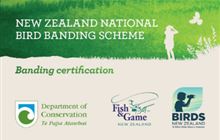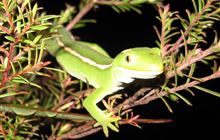Why we band birds
Introduction
Bird banding contributes to conserving our native birds, and the places where they live.Bird banding can help researchers answer these questions about birds:
- how many of that type of bird are there?
- where does it live?
- does it mate for life?
- how old is it and how long might it live?
- how many eggs will it lay during its life (if it's a female)?
- does it fly far away from here?
- where will it go?
- where does it feed?.
Researchers often need to recognise individual birds or groups of birds. One way is to attach bands or tags to the birds.
Researchers who use bands to study birds are called 'banders', in Europe they are known as 'bird ringers'.
The National Banding Office helps this research by supplying numbered metal bands and coloured bands to certified banding operators. These bands are usually fitted around the bird's lower leg (or tarsus).
Banding our birds
Since the first banding schemes started in 1947, over 1.4 million birds from 241 different species have been banded throughout New Zealand. On an annual basis we receive almost 1,500 reports of these banded birds that have been recovered, dead or alive.
A large number of banded New Zealand birds are migratory and have been found as far away as Australia, North and South America, South Africa, and Russia.
When a band is recovered from a dead bird or recorded from a captured bird, researchers are able to learn much about the bird.
Each band returned adds another item of information, such as how far the bird has travelled and how old it lived for and may even mean an entirely new discovery.
Metal bands are the most common form of banding carried out within New Zealand. Each metal band is stamped with a different number and the Department of Conservation, the Dominion Museum or National Museum of New Zealand address.
Our banding scheme
The New Zealand National Bird Banding scheme works with international banding organisations to track the movement of migrating birds throughout the world. The scheme keeps data on birds banded overseas but recovered in New Zealand, and vice versa.
Bird banding in New Zealand is controlled under the Wildlife Act 1953, and the Wildlife Regulations 1955. An authority (Wildlife Act Authority) is required before people other than DOC staff can capture, handle, mark or band protected, or partially protected bird species.
The National Banding Office is no longer responsible for issuing such authorities; applications need to be submitted to the Permissions Team in the Hamilton office.
For more information and application form see interacting with wildlife.
Bird banding history
Bird banding began in the 1940s, with the Wildlife Branch of the Department of Internal Affairs banding game birds and waterfowl.
By 1950, members of the Ornithological Society of New Zealand were banding all other birds, and from 1950 to 1967, the Dominion Museum assisted the Ornithological Society to process non-game banding.
In 1967, all New Zealand banding schemes merged into a single New Zealand National Bird Banding Scheme.
All records were held at the Wildlife Branch of the Department of Internal Affairs, which eventually became the Department of Conservation. On 1 April 1987, DOC took control of the New Zealand Bird Banding Scheme.
Today, the New Zealand National Bird Banding scheme supplies approved ornithologists throughout New Zealand, both professional and amateur, with bands and banding equipment.
All data collected for this scheme are kept at the National Banding Office, Department of Conservation, Wellington and are made available to researchers and ornithologists.


